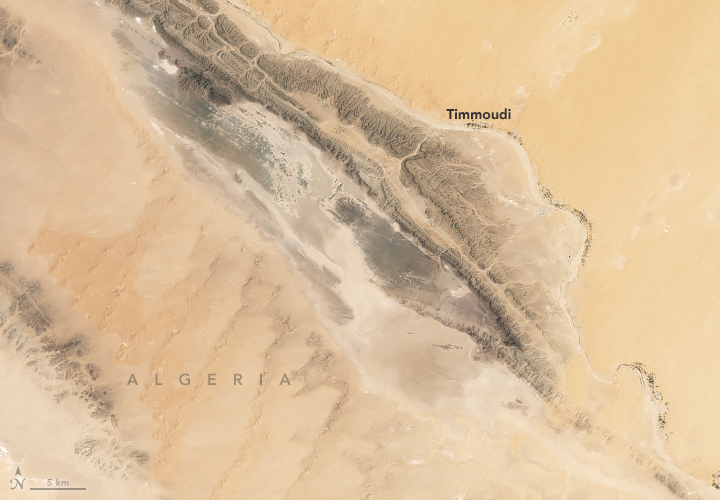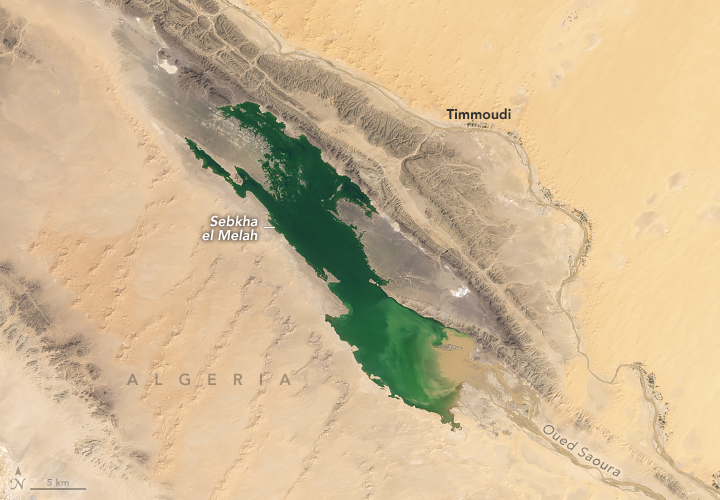

Water for a Desert Lake in Algeria
Downloads
- lakealgeria_oli2_20240812_lrg.jpg (2137x1484, JPEG)
- lakealgeria_oli2_20240929_lrg.jpg (2137x1484, JPEG)
Metadata
- Sensor(s):
- Landsat 9 - OLI-2
- Data Date: August 12, 2024 - September 29, 2024
- Visualization Date: October 17, 2024
Roughly 11,000 to 5,000 years ago, during the African Humid Period, the Sahara Desert was likely far wetter and greener. Geologic and archaeological evidence indicates that vegetation, wetlands, and perhaps even large lakes covered areas that are now oceans of sand.
In September 2024, hints of this more watery past emerged after an extratropical cyclone dropped a deluge of rainfall on parts of northern Africa. Runoff from the storm has partially filled several ephemeral desert lakes in normally dry areas.
The OLI-2 (Operational Land Imager-2) on Landsat 9 (right) captured this image of Sebkha el Melah, an ephemeral lake in Algeria, on September 29, 2024. The lake is situated along a ridge of the Ougarta Range and fed by the Oued Saoura, an ephemeral river (sometimes called a wadi) that enters from the southeast. The other image (left) shows the salt-encrusted lakebed on August 12, before the rain event. NASA satellites observed the lake beginning to fill in mid-September.
As of October 16, water covered 191 square kilometers (74 square miles) to a depth of 2.2 meters (7.2 feet), and Sebkha el Melah was roughly one-third full, said Moshe Armon, a senior lecturer at the Hebrew University of Jerusalem. Armon calculated these values using satellite images of the water’s extent, like the one above, along with a three-dimensional map of the lake’s bathymetry based on ICESat-2 observations. Since June 2000, only two other rain events have resulted in larger lake volumes—one in 2008 and one in 2014, Armon said.
The filling of a Sahara Desert lake is a “rare, largely undocumented, transient phenomenon,” noted Joëlle Rieder, a colleague of Armon’s, in a 2024 study that detailed the frequency of refilling events at the lake since 2000. This part of Algeria has few ground-based weather stations, so the researchers used rainfall data from NASA’s Integrated Multi-satellite Retrievals (IMERG) and ERA5 weather reanalysis data from the European Center for Medium-range Weather Forecasts (EMCWF) to study the meteorological conditions required to fill the lake.
Of the hundreds of rainfall events that affected Sebkha el Melah’s watershed since 2000, only six delivered enough water to start filling it. All of these involved long-lasting extratropical cyclones that produced especially heavy rainfall as moist tropical air was pushed up and over mountains, a process called orographic lift.
Satellite observations indicate that when Sebkha el Melah fills, the water can stick around. After it filled in 2008, it took until 2012 to dry completely. “If we don’t get any more rain events, a 2.2-meter depth, like we have now, would take about a year to evaporate completely,” Armon said.
Armon and other scientists track lake-filling episodes in part because questions remain about both the region’s past and future. Despite evidence indicating that the Sahara was wetter during the African Humid Period, just how wet remains a matter of scientific debate. To help resolve it, scientists look to desert lakes, like Sebkha el Melah, because they function a bit like giant “rain gauges” that provide clues about past precipitation patterns, explained Armon.
One of the challenges for researchers who study this topic is that models that simulate prior climate conditions struggle to reproduce the rainfall required to fill as many Saharan lakes as geologists believe were present during the African Humid Period. This has led some researchers to suggest that either the Sahara wasn’t actually as rainy and verdant as paleoclimate experts think or that the models are missing something, explained Armon.
“We’re proposing a third option: that extreme rain events, like the one in September in the northwestern Sahara, might have been more frequent in the past,” said Armon. “Given how long it takes lakes to dry up, these events could have been common enough to keep lakes partially filled over long periods—even years or decades—without frequent rainfall.”
It’s generally accepted by paleoclimatologists that small orbital variations called Milankovitch cycles were key drivers of the African Humid Period because they would have caused slight changes in the distribution of solar radiation and shifts in the strength and position of the North African monsoon. Less clear is whether and how much the Sahara might green and support long-lasting lakes in future centuries and millennia as the impacts of greenhouse gas emissions and climate change are layered onto the cyclical effects of the Milankovitch cycles.
Projections from the Intergovernmental Panel on Climate Change (IPCC) indicate that while parts of the Sahara may receive more rainfall as global temperatures increase, other parts may receive less. “But the uncertainties in these projections are larger than the projected changes,” said Armon. “What’s going to happen in the Sahara remains very unclear, but we hope that we’ll eventually develop a better understanding of the Sahara’s future by studying these lake-filling events.”
References
- Armstrong, E., et al., (2023) North African humid periods over the past 800,000 years. Nature Communications, 14, 5549.
- Armon, M. (2024) Saharan rainfall climatology and its relationship with surface cyclones. Weather and Climate Extremes, 43, 100638.
- Armon, M. (2020) Determining Bathymetry of Shallow and Ephemeral Desert Lakes Using Satellite Imagery and Altimetry. Geophysical Research Letters, 47(7), e2020GL087367.
- Chandan, D. & Peltier, R. (2020) African Humid Period Precipitation Sustained by Robust Vegetation, Soil, and Lake Feedbacks. Geophysical Research Letters, 47(21), e2020GL088728.
- CNN (2024, October 14) The Sahara Desert flooded for the first time in decades. Here’s what it looks like. Accessed October 18, 2024.
- The Conversation (2023, December 15) The Sahara Desert used to be a green savannah — new research explains why. Accessed October 18, 2024.
- deMonocal, P. & Tierney, J. (2012) Green Sahara: African Humid Periods Paced by Earth’s Orbital Changes. Nature Education Knowledge, 3(10),12.
- Intergovernmental Panel on Climate Change (2021) Climate Change 2021. Accessed October 18, 2024.
- Intergovernmental Panel on Climate Change (2021) Total precipitation (PR) Change % - Long Term (2081-2100) SSP5-8.5 (rel. to 1850-1900). Accessed October 18, 2024.
- NASA Earth Observatory (2021) Sizing Up Remote Lakes. Accessed October 18, 2024.
- Popular Mechanics (2023, October 17) The Sahara Desert—Yes, That One—Remarkably Grows Green Every 21,000 Years. Accessed October 18, 2024.
- Quade, J., et al. (2018) Megalakes in the Sahara? A Review. Quaternary Research, 90, 253-275.
- RealClimate (2022, February 6) Future rainfall over Sahel and Sahara. Accessed October 18, 2024.
- Reider, J. et al., (2024) Meteorological ingredients of heavy precipitation and subsequent lake filling episodes in the northwestern Sahara [preprint]. EGUsphere.
- University of Bristol (2023, September 13) New research reveals why and when the Sahara Desert was green. Accessed October 18, 2024.
NASA Earth Observatory images by Michala Garrison, using Landsat data from the U.S. Geological Survey. Story by Adam Voiland.
This image record originally appeared on the Earth Observatory. Click here to view the full, original record.